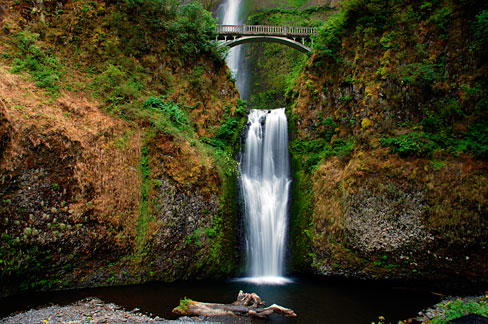In play right now in Congress are two bills that would elevate the conservation status of 442,620 acres of public land in Oregon.
Read MoreForest Service
The Calapooia River near Crawfordsville. Source: Wikimedia Commons.
Tipping Over Old-Growth Trees in the Name of Salmonid Conservation
The Forest Service is proposing to mechanically push over at least thirty perfectly healthy and very tall and very large old-growth Douglas-fir trees into the uppermost Calapooia River.
Read MoreLessons from Salem: Protecting Local Drinking Water Supplies

Alas, a full-on Bull Run solution is not possible for every other municipal water supply in Oregon, but more could be done.
Read MoreThe National Wild and Scenic Rivers System, Part 2: Rounding It Out and Cleaning It Up (For Oregon, If Not Elsewhere)

Currently, less than 1 percent of Oregon streams, by mileage, are included in the National Wild and Scenic Rivers System. An estimated additional 10,000 miles (less than 3 percent of the total mileage) of Oregon streams are eligible for inclusion.
Read MoreThe National Wild and Scenic Rivers System, Part 1: A Vital National Conservation Purpose

There are times when Congress acts in a visionary manner. (Is it less so today, or is it just me?) Such was the case in 1968 when it enacted into law the Wild and Scenic Rivers Act.
Read MoreDefensible Space: The Best and Only Hope for the Homeowner In or Near a Forest

If one is going to live in or near a forest, one assumes a higher risk of fire. The best way to minimize that risk is to seriously and continually create and maintain defensible space. It’s not cheap. If it were, it would have been done already.
Read MoreMore Moral Hazard Than Fire Hazard: The Responsibility of Homeowners in the WUI

In the backcountry, fire is wonderful, necessary, and inevitable.... In the frontcountry, fire is awful, unnecessary, and preventable.... The biggest problem with fire occurs where the frontcountry meets the backcountry, the bureaucratically named wildland-urban interface (WUI: “woo-ee”).
Read MorePreremembering Barbara Roberts, Oregon Conservationist

Millions of acres of federal old-growth forest still stand because of former Oregon governor Barbara Roberts (D). The Upper Klamath River would have another damn dam and not be safely within the National Wild and Scenic Rivers System if not for Roberts. Oregon would have some god-awful cyanide heap leach gold mines if not for her. If not for her . . . (there’s much more).
Read MoreThe Columbia River Gorge Is Dead; Long Live the Columbia River Gorge—Unless Greg Walden Has His Way

In 1986, Congress enacted the Columbia River Gorge National Scenic Area Act to, among other things, “establish a national scenic area to protect and provide for the enhancement of the scenic, cultural, recreational, and natural resources of the Columbia River Gorge.” In 2017, Representative Greg Walden (R-2nd-OR) proposes to throw it out the window.
Read MoreThe Columbia River Gorge Is Dead; Long Live the Columbia River Gorge—Unless Greg Walden Has His Way
Everyone—including many a card-carrying conservationist—just needs to take a deep breath. Yes, there was a relatively large forest fire mostly on the Oregon side of the Columbia River Gorge. However, the clearing of the smoke gave proof through the day that our gorge was still there. The Columbia River Gorge was not “destroyed,” “lost,” “gone up in smoke,” “consumed,” or “dead,” as suggested by generally hyperbolic media reports by generally hysterical reporters, often quoting generally hysterical gorge lovers.... Neither volcanic eruptions nor forest fires can be prevented—and that’s a beautiful thing.
Read MoreDancing on the Dark Side: Wyden Guts His Own National Recreation Area System Bill

Senator Ron Wyden had a visionary and bold bill that would establish a National Recreation Area System. I strongly supported that legislative provision in a post to this Public Lands Blog.... I heaped praise on the Wyden-Blumenauer bill that would have established generally strong conservation and management standards for new national recreation areas.... Now I must heap scorn on the Wyden-Bishop bill. The section that would establish a National Recreation Area System has been gutted of any significant conservation value and would only change the color on the map, but not management on the ground.
Read MoreThe Proposed Oregon Wildlands Act of 2017: Very Good but Not Yet Great

The congressional conservation pipeline is clogged. This is not because it is too full of fine legislation that would elevate the conservation status of certain public lands by designating wilderness, wild and scenic rivers, and other special protection areas, but because of the general dysfunction of Congress. (I hear it was worse before the Civil War.) One bill in that pipeline, sponsored by Senator Ron Wyden (D-OR) and cosponsored by Senator Jeff Merkley (D-OR), is the proposed Oregon Wildlands Act (OWA) of 2017 (S.1548, 115th Congress).
Read MoreClosing the Mining Loophole for Wild and Scenic Rivers

The federal public lands along more than half of the stream mileage in the National Wild and Scenic Rivers System (NWSRS) can be mined, notwithstanding its congressional “protection” in wild and scenic rivers (WSRs). This is because the Wild and Scenic Rivers Act of 1968 (WSRA) established three different classifications for WSR segments—wild, scenic, and recreational—and banned mining or not based on the classifications. The WSRA needs fixing to offer uniform protection against mining in the NWSRS.
Read MoreNow That’s a Member of Congress!

With some tweaks, the proposed Northern California Conservation and Recreation Act can be a great bill that when enacted into law will be a gift of enduring benefit to this and future generations of North Coast Californians, all Californians, and all Americans.
Read MoreThe Westerman Bill: The Timber Industry’s Wet Dream

Who wouldn’t want “resilient” (“able to withstand or recover quickly from difficult conditions”) forests? With the name Resilient Federal Forests Act of 2017 (H.R.2936, 115th Congress), what could possibly be wrong with this bill?
Everything. Judge neither a book by its cover nor a bill by its name.
Introduced by Representative Bruce Westerman (R-4th-AR), the bill is the timber industry’s wet dream legislation. In only his second term in Congress, Westerman has received more campaign contributions from Big Timber than any other industry.
The Westerman bill would legislate horrifically harmful public forest policy into law.
Read MoreIncreased Wilderness Demand Calls for Increased Wilderness Supply
The demand for wilderness and parks is most likely to increase despite any best efforts to limit Oregon's, so what about the supply of wilderness?
Read MoreFederal Systems for the Conservation and Enjoyment of Lands and Waters

Federal conservation systems are an unqualified social good and generally provide elevated protection and better management to important federal public lands and to resources and areas of high national significance. All existing federal conservation systems could be improved, and none should be weakened or discarded. Those that haven’t yet been codified by Congress need to be.
Read MoreFederal Payments to Timber-Addicted Counties
In 1927, Justice Oliver Wendell Holmes noted, “Taxes are what we pay for civilized society.” The timber-addicted counties need to become more civilized.
Read MoreThe High Cost of Cheap Grazing

It costs more to feed a domestic housecat than to graze domestic livestock on federal public lands.
Read MoreCrabtree Lake in Crabtree Valley, home to some of the largest and oldest trees in Oregon, located on western Oregon public lands administered by the Bureau of Land Management, in Linn County, is part of the proposed Douglas-Fir National Monument. Photo: David Stone, Wildlands Photography.
A Monumental Battle, Part 2: National Monuments in the Congress
There is no question that an Act of Congress can eliminate, shrink, or weaken a national monument proclaimed by a president pursuant to authority granted by Congress. What Congress giveth, Congress can taketh away. The property clause of the U.S. Constitution (Article 4, Section 3, Clause 2) ensures that. Yet in fifty-five Congresses over the past 110 years, Congress has rarely acted to eliminate, reduce, or weaken a national monument proclamation by a president.
Read More

